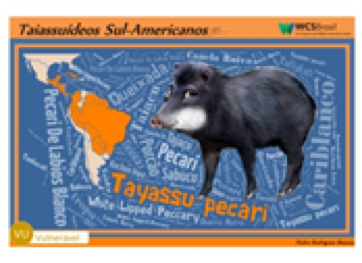
QUEIXADA, TAIAÇU, TAJAÇU, TACUITÉ, SABUCU, PECARI DE LÁBIOS BRANCOS, CANELA RUIVA, QUEIXO RUIVO, TIRIRICA, TAÑYKATI, TANHOCATI, TROPA, TROPERO, CHANCHO DE TROPA, CHANCHO DE MONTE, WARI, HUANGANA, PINGO, PECARI LABIADO, CARIBLANCO, SENSO, WHITE-LIPPED PECCARY, PECARI A LIÉVRES BLANCHES
Scientific Name: Tayassu pecari
Habitat: From dense tropical forests to savanna with semi-arid vegetation or desert of the three Americas, between Southern Mexico and Northern Argentina.
Size: Medium, average adult weight 30 kg
Characteristics and behavior: Black coat with white spot on the chin (mandible), no sexual dimorphism (differences in appearance between males and females). Piglets are born with light and dark brown spots. Wide and large tusks, facing downward. Front hooves have two large toes that support their weight, and two small toes that only appear in their footprints left in soft soil. Hind hooves have three toes. They have various vocalizations and gnash their jaws in stressful situations.
Males, females, and piglets travel in herds with dozens or hundreds of individuals. Some records show herds with 300 individuals. Usually 1 to 2 pups (fraternal twins) are born per gestation per year. In the herd, ratio of male and females is almost equal. Everyone in the herd is related, so they are very social and protect each other when threatened. Active during the day and at night, although they are preferably diurnal. Feed mainly on fruits, but also eat leaves & grasses, aquatic plants, seeds, mushrooms, larvae, earthworms, and from time to time, even fish.
Status: Vulnerable
Read more on the IUCN Red List of Threatened Species: http://www.iucnredlist.org/details/41778/0